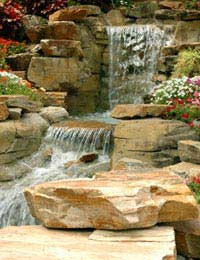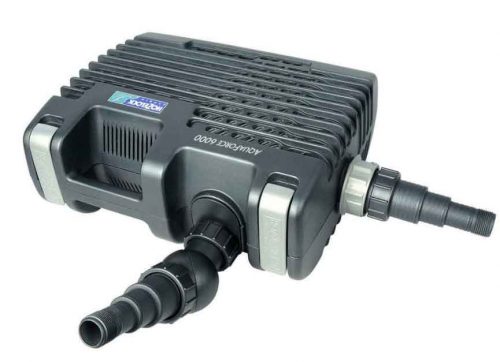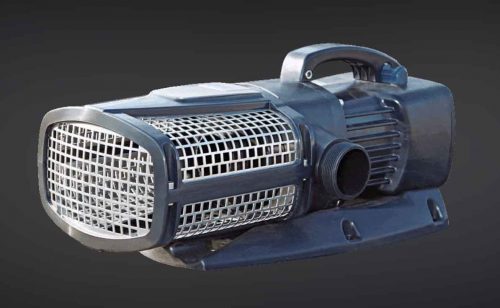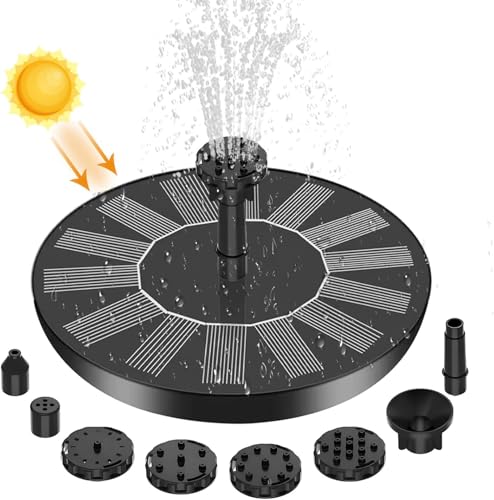 Few sounds are as relaxing as the gentle splash of running water – and for many of us the thought of being able to enjoy that alone is one of the main reasons for wanting a pond in the first place. A waterfall looks particularly effective for an informal or wildlife pond – as well as helping to keep the water oxygenated – and with a bit of careful planning, making one is not particularly difficult to do.
Few sounds are as relaxing as the gentle splash of running water – and for many of us the thought of being able to enjoy that alone is one of the main reasons for wanting a pond in the first place. A waterfall looks particularly effective for an informal or wildlife pond – as well as helping to keep the water oxygenated – and with a bit of careful planning, making one is not particularly difficult to do.
First Steps to building a waterfall for your pond
The waterfall itself can be as simple or as complicated as you wish to make it, even to the extent of having an artificial stream with several mini-waterfalls along the way. Whatever the design, the idea is very straightforward – water is pumped from the pond up to a smaller collecting pool and then flows back into the pond. There are two main ways to create the main part of the feature, either using one of the pre-formed waterfalls available – which can be linked together to create a cascade – or a flexible liner. For a cascade effect, deciding between them really comes down to personal choice, but for anyone looking to install a simple waterfall fairly quickly and with the minimum of fuss, the pre-formed mouldings are hard to beat. Although concrete can also be used, the need to seal and waterproof it to stop chemicals leaching out into the water generally makes it less convenient.
To give the water the height it needs to flow back properly, some earth works are probably going to be needed – an excellent use for the soil dug out when the original pond was excavated. Many pond builders combine this with a rockery, which tends to make the waterfall itself fit in better. Whether you are going for natural-looking cascades flowing at different angles or more of a curtain of water, the next job is to work out the rough form of the waterfall. At this stage, the hosepipe that will carry the water from the pump up to the top of the fall should be buried – making sure to leave a bit of extra length just in case – and the soil firmed down well to avoid it dropping later.
What kind of waterfall should I use?
If pre-formed units are being used, you need to work out how they are going to fit together and shape their resting places accordingly. With a liner, you have a blank canvas, but need to pay more attention to forming the actual “bowls” if the feature is to run properly. If you are creating a series of cascading pools with a liner, they should slope backwards slightly to make sure that they fill up properly and stop any stones used to decorate the waterfall from simply getting washed all the way down and into the pond. It also helps to make the whole thing look more natural. Pre-formed or liner built, remember to plan to have the final lip overhanging the pond by five or ten centimetres to get a good splash.
More: How to illuminate your waterfall
With the earthworks ready, the actual installation is very much like putting in the original pond – checking that everything is level and remembering a protective layer in the case of a liner or making sure that the moulding is properly supported. To be on the safe side, some pond builders like to cement pre-formed pools in place.
Once everything is ready, the hose pipe connected and the pump switched on, if the result is not quite what you were expecting, all is not lost. Different arrangements of stones in the waterfall pools – especially near the lip – can change the way the water flows, so it is worth experimenting a bit to find an effect that works for you. However, if the Niagara look-alike of your imagination is more like a trickling hosepipe in reality, your pump is probably too small – or its filter is blocked – but the good news is, both are easy enough to remedy!
More:
- Should you leave a pump running 24/7?
- Reasons why pond pumps should be placed at the bottom of your pond
- What kind of pond pumps are available?
What size pond pump should I use for a waterfall?
Sizing the pump is one part of pond-keeping that is often overlooked, at least until it becomes a problem. As a general guide, for every one centimetre width of waterfall, you need a pump capable of delivering around 150 litres of water per hour – perhaps up to 200 litres per hour if you really do want to rival Niagara! On this basis, a 3000 litre per hour pump, for instance, would be fine to feed a 20cm wide waterfall.
At its best, water gardening, like all gardening, involves a bit of effort at the time to be rewarded by a lot of pleasure later and giving your garden pond a waterfall is probably one of the best examples of this. There really is nothing quite like sitting out on a sunny day beside running water – and with a spot of creative lighting, your waterfall can become a dramatic evening feature too.
A pond waterfall feature will turn your backyard pond into a breathtaking beauty! Thanks to so many companies selling easy to assemble waterfall kits, it is now very simple for anyone interested in a pond waterfall to build it by themselves.
Pond waterfalls, which size?
Waterfall pond features are ideal for any size ponds even small ones. The reflection of water with the mesmerising sounds make the space much more homely. The sounds waterfalls produce is not the only benefit of having them, waterfalls also increase aeration in the water to keep the fish healthy and the ecosystem balanced and beautiful.
How to choose a waterfall for your pond
Choosing a waterfall solely depends on the aesthetic you are going for but there are some things that you should know about. Make sure that the waterfall blends with your pond and the surroundings, it is not supposed to look like an outcast but an effortless beauty in coherence with the water. The waterfall could be made with all natural materials such as rocks and greenery surrounding it or with colourful pots as well. Choose bigger stones to frame the waterfall and the smaller ones to cover the area that is left. The kits available in the market will make your task even easier, these kits come with a pump usually made of stainless steel material that promises a long lasting setup. The whole kit is flexible and can be manipulated to fit your view of a waterfall.
Tips for adding a waterfall to your pond
There are a few tips that could help you get started with the process. After you have framed the waterfall with larger stones make sure to soften the edges with greenery. These could be your favourite plants or pond plants that compliment your house. If the waterfall is hidden from the windows, it will automatically make it very invisible. Waterfall facing a window creates a dreamy feeling inside your house as well. A longer waterfall could be supported by turns that elevate its look and make it look majestic. Creating turns in a waterfall is a tricky part, so take your time whether you are working with a kit or making it by scratch. Perhaps the easiest way to build a waterfall would be trusting a kit that will save your trips to the store to buy the materials. It also does not require maintenance for a long time after you have installed it. These re-circulating water streams will give a close to nature voice to your pond where the fish create a living scenery!
Waterfall Pumps
Waterfall pumps are essential to get the water moving around to feed your waterfall
Pond Waterfalls and Fountains
How do you make a waterfall feature?
Creating a waterfall feature involves several steps. First, collect rocks and gravel to build the waterfall. Next, select the location for the waterfall and mark the area. Then excavate the traced area and make sure the area is level. Lower in the reservoir and prep the pump and plumbing. Finally, backfill the soil around the reservoir to complete the construction. This will provide an attractive and functional addition to your pond or water garden.
Does a waterfall oxygenate a pond?
While waterfalls are effective in circulating and aerating the surface of a pond, they may not fully oxygenate the bottom of the pond. Most water gardens rely on waterfalls to aerate the water, but other methods such as aquatic plants and streams can be used to provide additional aeration.
How often should you run a waterfall in a pond?
A good rule of thumb is to circulate the pond at least once every hour. This will ensure that the water is adequately circulated, preventing stagnation and promoting healthy plant and fish life.
What size pond pump do I need for a waterfall?
To achieve a typical waterfall effect, a pump with a flow rate of 100-150 gallons per hour (GPH) per inch of waterfall width is recommended. For instance, a 12-inch waterfall spillway will require a pump that provides around 1200-1800 GPH.
How do you maintain water in a waterfall?
To maintain water in a waterfall, replenish the reservoir once a week. In hot weather, you may need to refill the reservoir more frequently. The general rule is that the smaller the reservoir, the more often it should be checked and refilled to prevent dry running of the pump.
Is a waterfall good for a pond?
Yes, adding a waterfall to a pond can have several benefits. It increases the circulation and agitation of the water, oxygenating the pond and improving the quality of life for fish and plants. Additionally, it can enhance the filtration of the pond.
What are the benefits of a waterfall?
Adding a waterfall to your pond can instantly improve your mood, as the sight and sound of flowing water are soothing. It can also promote relaxation and mental health, and even lower blood pressure. Additionally, it can increase the circulation and aeration of the pond, leading to improved water quality and filtration.
Do you need an air pump if you have a waterfall?
While waterfalls and fountains provide great display, circulation, and aeration, it is recommended to install an air pump alongside it to thoroughly aerate the pond. This will ensure the pond receives adequate oxygenation and prevent an anaerobic environment from developing on the bottom of the pond.
Does a waterfall add oxygen to a pond?
Yes, waterfalls can add oxygen to a pond by disrupting the water’s surface and promoting circulation. By keeping the water moving, whether through a waterfall, stream, or aquatic plants, more oxygen can be introduced into the water.
Does a waterfall add oxygen to a fish pond?
While waterfalls can provide some aeration to a fish pond, they may not fully oxygenate the bottom of the pond. This can lead to an anaerobic environment that is unsafe for fish and increases organic build-up. Other methods such as aquatic plants and air pumps can be used in conjunction with a waterfall to provide adequate oxygenation.
How does a pond pump work for a waterfall? Submersible pond pumps operate by using an electric motor to drive an impeller. As the impeller turns, water is drawn in one side of the pump and expelled out the other, determining the amount of water flow. The power and size of the impeller are factors that determine the flow rate of the water.
In conclusion, waterfalls can be a great addition to a pond or water garden. While they may not fully oxygenate the bottom of the pond, they do provide several benefits such as increasing circulation, enhancing filtration, and promoting relaxation. It is important to choose the right size pump for your waterfall and to maintain the water to prevent issues such as dry running of the pump. Additionally, it may be necessary to use other methods such as air pumps and aquatic plants for adequate aeration. By following these guidelines and taking care of your pond or water garden, you can enjoy the sight and sound of a beautiful waterfall while ensuring the health and well-being of the fish and plants in your aquatic environment.
























Want to build a pondless waterfall. Having trouble finding the kit needed in uk all seem to d be in the USA. Anyone have details for suppliers. Cheers Alan.
You don’t need to buy a waterfall kit to make a pondless waterfall. I bought a pond liner, hose, 80 litre plastic storage box and a sheet of fibreglass to cover the box. I made an 50cm diffuser. Works just as good as the USA Aquascape range kits ($1000-3000)….but the total cost apart from the pump was less than £100. I already had a 1000 gallon per hour pump